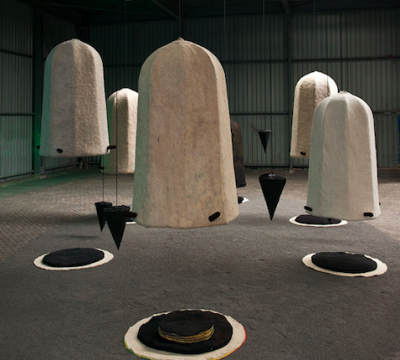ton van der laaken
The works of Ton van der Laaken (Breda, 1952) are ‘silent interventions’. Mental spaces that offer the visitor the possibility of experiencing silence. From here, one can develop the ‘Right Action’, in any given sphere. Over the space of many years, he has collected impressions of the way in which light is manifest in the empty space. He captured these impressions through a variety of media. During his travels, he photographed light in empty spaces, such as empty corners, factories, bunkers, Egyptian excavation sites, monasteries, a prison and a parking garage.
Ton van der Laaken studied at the Academy for Visual Arts in Arnhem and the Jan van Eyck Academy in Maastricht. Since 1996 he has been teaching Experimental Visual and Spatial Concepts at the University of Applied Science in Düsseldorf, Germany. His work has been displayed in, among other places, Amsterdam, Rotterdam, Nijmegen, Brussel and Barcelona.
With black, everything becomes possible
In the futuristic opera Victory over the Sun (1913), Russian artist Kazimir Malevich introduces an idea which he perfects two years later in the most famous painting he will ever create: The Black Square. The backdrop used in the opera consisted of a black curtain. The curtain itself is not an image, no part of the performance: it hides it and reveals it. That black curtain ‘is the embryo that makes everything possible’, Malevich later writes in a letter to a friend. Black is a possibility, black opens up spaces, sketches panoramas. Black can give everything meaning.
It is a notion which does not enjoy much popularity in western culture. Black is the colour of the night and must be ‘conquered’ by the day — every single day. Black exists for devils, cats and crows. Black signifies misfortune, a broken heart, mourning and other adversity. So people say.
This notion does not apply to artist Ton van der Laaken (1952). The black in his installation Secret Sky is of an exhilarating spaciousness. Secret Sky consists of six felt cocoons, which can — by means of a black, pointed counterweight — be raised and lowered over a human body. Five of the clock shaped cocoons are intensely off-white, one of them is black. Those who choose to sit on a cushion inside the felt and pull the cocoon down over them, dip themselves into complete darkness. All visual stimuli are eliminated.
What happens?
Initially, nothing. Avoid the urge to close your eyes. Secret Sky works best with eyes wide open. For then, says Van der Laaken, ‘you can best see the space’. Then the thoughts begin to stream: from outward, they turn inward and eventually even deeper in. Ideally, a situation arises that the Tao refers to as ‘Wu Wei’. Wu Wei is a consciousness of existing inside of time, a conscious non-doing. Those who take place inside one of Van der Laaken’s cocoons, will slowly begin to experience a unity between themselves and the world, between body and mind. It is a unity that is no longer related to darkness and light, to here and now, to why and how so. Within the concealment of Secret Sky you create a heaven of your own.
Van der Laaken’s installation is made of felt, a tactile, soft, gentle material. Felt is also a beautiful material, offering warmth and comfort. However, this does not mean that felt is an obvious choice for an artist to use in his work. Van der Laaken trained as an architectural draughtsman, attended the art academy in Arnhem and the Jan van Eyck in Maastricht. Conceptual art was on the rise, Van der Laaken spent ten years working for the American conceptual godfather Sol Lewitt.
As a young artist, Van der Laaken creates perfect drawings of imaginary spaces. Time and again. Imperfection is simply deleted. A four-month trip on the Trans-Siberian Express and a residency in a Tibetan convent bring about change. Why all those years of concept and technical perfection? Why not more intuition, spontaneity, imperfection? The artist contemplates it in amazement. Once returned to the Netherlands, the smoothness of perfection is renounced. A world of contradictions comes together.
And he succeeds at this with the cocoons of Secret Sky, which stand there as if they have always been there, when in truth they have a long, troublesome history of origin. Van der Laaken is not a felt artist, as Claudy Jongstra is. During the experimental phase of Secret Sky he works with a variety of materials. First with wood, but that makes the cocoons bear too much semblance to a resonance box, which is not what the artist is aiming for. He then considers fabric, but with that material, the cocoons look too much like tents. He experiments, tests, doubts, spends hours walking his dog across the Veluwe. One day, when his dog is off chasing some wild animal and he sits waiting by a lakeshore, he spots a bulrush with a ‘cigar’ full of seed-fluff — soft, loose, perfectly shaped. He cuts the cigar off, takes it home and draws it. The sensation of felt is born. And so the coincidentally acquired bulrush gets a place in Van der Laakens thoughts. Similarly, the human being organically gets a place in his work. The cocoons are grafted to Van der Laaken’s own height. The human size is, very practically, a conditio sine qua non. Secret Sky may, in its midst, offer a glance at heaven, at the end of the exhibition, Van der Laaken will lower the cocoons down to the ground, take them apart and stuff them into the trunk of his Ford station wagon.


